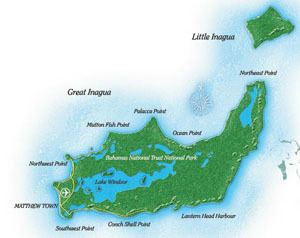Area 1,679 km2 | Founded 1800 | |
 | ||
Map of Inagua
Inagua is the southernmost district of the Bahamas, comprising the islands of Great Inagua and Little Inagua. The headquarters for the district council are in Matthew Town.
Contents
- Map of Inagua
- Assassins creed 4 black flag great inagua secrets locations
- Assassins creed iv black flag walkthrough great inagua chests collectibles guide
- History
- Great Inagua
- Little Inagua
- References
Assassins creed 4 black flag great inagua secrets locations
Assassins creed iv black flag walkthrough great inagua chests collectibles guide
History
The original settler name Heneagua was derived from a Spanish expression meaning 'water is to be found there'. Two names of apparent Lucayan origin, Inagua (meaning "Small Eastern Island") and Baneque (meaning "Big Water Island") were used by the Spanish to refer to Great Inagua.
Several documented treasure laden ships were destroyed on Inaguan reefs between the years of 1500 and 1825. The two most valuable wrecks lost off the Inaguas were treasure-laden Spanish galleons: the Santa Rosa in 1599 and the Infanta in 1788. Other ships of considerable value that were wrecked there include the French Le Count De Paix in 1713, the British HMS Lowestoffe in 1801, and the British HMS Statira in 1815.
Henri Christophe, king of northern Haiti from 1811 to 1820, built a summer retreat at the Northeast Point of Great Inagua. Local legend has it that he also buried a cache of gold there.
There is evidence of salt production being shipped to Spanish colonies as early as the 1600s, and its extraction was a going business by 1803. After World War I lower salt prices and competition had driven the small producers on Great Inagua out of business, and the salt works were abandoned except for incidental local use. In 1935 the Erickson brothers from Massachusetts founded West India Chemicals Ltd., purchasing the abandoned salt works from the British government. They drilled test holes, set up offices and began restoration of the buildings, but the locals who feared changes in the status quo power structure felt threatened and in August 1937 a riot broke out, an employee was killed, and the Ericksons were forced to flee. They soon returned and full-scale development resumed. In the mid-1950s Morton Salt bought the Great Inagua saltworks, which includes over eighty salt ponds, and is the second largest such operation in North America. Morton is the major employer on the island.
Great Inagua
Great Inagua is the second largest island in the Bahamas at 596 sq mi (1544 km2) and lies about 55 miles (89 kilometres) from the eastern tip of Cuba. The island is about 55 by 19 mi (89 by 31 km) in extent and mostly flat with some sand hills, the highest points being East Hill at 132 ft (40 m), Salt Pond Hill at 102 ft (31 m), and James Hill at 90 ft (27 m). It encloses several lakes, most notably the 12-mile (19 km) long Lake Windsor (also called Lake Rosa) which occupies nearly a quarter of the interior. The population of Great Inagua is 913 (2010 census).
The island's capital and only harbour is Matthew Town, named after George Matthew, a 19th-century Governor of the Bahamas. This town houses the Morton Salt Company’s main facility, producing one million tonnes of sea salt a year — the second largest solar saline operation in North America and Inagua's main industry.
Great Inagua Airport (IATA: IGA, ICAO: MYIG) is located nearby.
There is a large bird sanctuary in the centre of the island with a population of more than 80,000 West Indian flamingoes and many other bird species, including the Bahama parrot, Inagua woodstar, Bahama pintail, brown pelican, tricolored heron, snowy egret, reddish egret, stripe-headed tanager, double-crested cormorant, Neotropic cormorant, roseate spoonbill, American kestrel, and burrowing owl. The Union Creek National Reserve is specially set aside for the study of green sea turtles (Chelonia mydas).
Little Inagua
The neighbouring Little Inagua five miles (8 km) to the northeast is uninhabited and occupied by a large Land and Sea Park. It is 30 sq mi (78 km2) and has herds of feral donkeys and goats (descendants of stock introduced by the French). Endangered sea turtle species breed on the island. Little Inagua has a large protective reef extending up to a mile away from the island in all directions around it, that prevents boats from coming too close.
